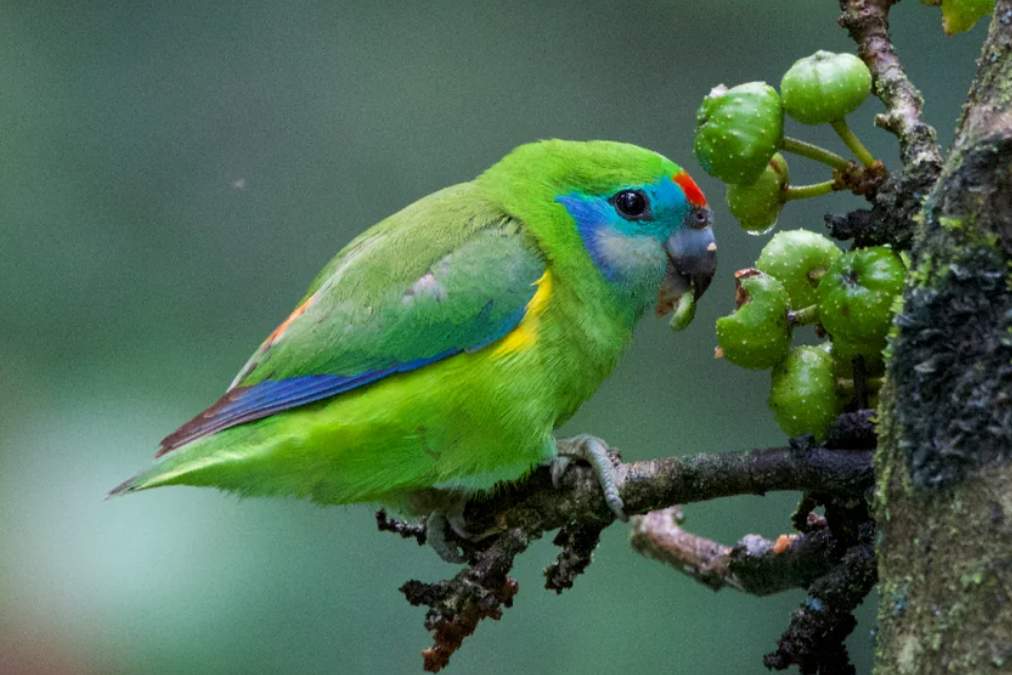Habitat: The yellow-tufted honeyeater (Lichenostomus melanops) is found throughout their range in healthy eucalypt woodlands and open forests in southeastern Australia. Yellow-tufted honeyeaters live and breed in discrete colonies of 15–100 birds or more, often along creeks. There are often many variations in appearance between birds in different colonies, with those in high mountains or southern latitudes being larger than others elsewhere.

Races: Even so, there are only four distinct races.
-
The larger and more brilliantly colored of the two is the Helmeted Honeyeater, L. m. cassidix, previously regarded as a distinct species. Once widespread in western Gippsland, Victoria, it is now restricted, through habitat clearing, to a tiny area on Woori Yallock Creek near Yellingbo. Today, the population probably numbers no more than 100–150 birds. Recent shifts in local drainage have adversely affected the eucalypt woodland in which the birds live and made them more susceptible to insect attack. This in turn has brought in the pugnacious Bell Miner, which specializes in sap-sucking insects and also competes with and drives out the smaller Helmeted Honeyeater.
-
The other race, L.m. melanops, Gippsland yellow-tufted honeyeater is shorter-tailed and tufted on the forehead and has a paler back and a less clear-cut cream-tipped tail. It ranges along both scarps of the Great Dividing Range in New South Wales and north into southern It also ranges southwest to the Grampians, Victoria, and southeast to South Australia. Between it and the Helmeted Honeyeater along the southeastern gullies of the Range in central and eastern Gippsland is an extensive intergrazing population. This population was formerly treated as a separate race, L.m. gippslandica.
-
m. melanops, Sydney yellow-tufted honeyeater
-
m. meltoni, Inland yellow-tufted honeyeater, is duller in plumage and has a smaller tuft, which was described by G. M. Mathews in 1912.
Whatever their appearance differences, all colonies are similar in their calls, habits, and behavior. Coastal colonies, including Helmeted and Gippslandica honeyeaters, are sedentary and permanent in creekside eucalypts. Those in the summit gullies and along the western scarps of the Great Dividing Range wander in autumn and winter, generally shifting northwards and down to lower altitudes.
Diet: Everywhere they feed in foliage on insects and their sugary secretions: honeydew lerp, and particularly during breeding manna, the sugary sap that exudes from damaged plant tissue. Nectar is also taken; coastal colonies exploit it only when local trees flower, and those inland roam more widely to follow blossoming. Most insects are taken by gleaning over leaves in the mid and upper strata of trees. However, in summer and autumn, helmeted honeyeaters shift to the shrub layer to forage. Moreover, all populations hawk occasionally for flying insects. Often, they capture insects on tree trunks, like tree creepers. Some colonies spend up to 30 percent of their time foraging this way. Roaming groups return to their parental breeding grounds to nest each spring and summer, up to 50 pairs in about 10 hectares of territory. Parents feed the young, and helpers may help.
Alternative Names: It is also known as the Helmeted Honeyeater, Black-faced Honeyeater, Yellow Whiskers, and Whisky.
Size: The yellow-tufted honeyeater measures about 175-230 mm long.
Identification: Both sexes are similar. The forehead, crown, and nape are green-yellow, contrasting with a darker back; forehead feathers form tufts of varying length. The back side has various shades of brown-olive; flight feathers and tail dark brown with green-yellow edges; and cream tips to tail feathers. Broad black sash through the eye to ear coverts; ear tuft chrome-yellow; lower cheeks and throat yellow, with a dark central line from chin to upper breast. The rest of the underparts are yellow-green with heavy black streaks on the breast. The eyes are red-brown. Bill is black. The feet are dark gray. The immature bird has yellow areas that are greener and duller; the gape flange is cream to lilac.
Vocalizations: Yellow-tufted Honeyeater’s call is a loud, harsh churr that comprises the bulk of its repertoire, used for contact and in chorus in group displays (apparently for colony advertising). The alarm notes are a little harsher and more urgent. Despite this, its song is infrequent, sweet, and whistling in nature. Around flowering trees, it aggressively defends its territory with a variety of calls.
Nesting: Breeding takes place in June–March, mostly August–January. Nesting a cup of bark strips and grass, bound with cobwebs and cocoons, lined with fine strips of bark, grass, feathers, or hair, suspended from the surface in low shrubs or small trees 0.3–4 meters above ground in the horizontal fork or where several stems interlace.
Eggs: Yellow-tufted The honeyeater usually lays two eggs, but rarely three; smooth, dull flesh, buff to white, spotted and blotched with chestnut, purple-red, and purple-grey, mainly on the larger end of the zone; oval, about 23 x 16 mm. Incubation takes about 14 days. Young will fly in 13 days.
Distribution: Yellow-tufted honeyeater is found in colonies in shrubby eucalypt forest and woodland, often along creek sides, on the coast and inland scarps of the Great Dividing Range. It is found north to the Carnarvon Ranges and Blacktown Tablelands, Queensland, and southwest to the Grampians, Victoria, and southeastern South Australia. These races are intergrading in central and eastern Gippsland.
Status: Least Concern
Family: Meliphagidae
Genus: Lichenostomus
Order: Passeriformes
Read More: Yellow-spotted honeyeater (Meliphaga notate)







